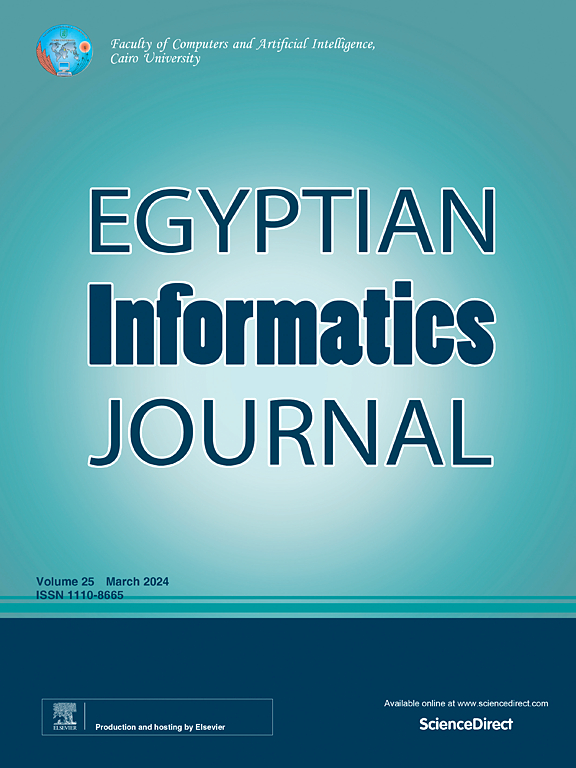医疗保健4.0中用于安全远程外科手术的深度学习编排大蒜路由架构
IF 4.3
3区 计算机科学
Q1 COMPUTER SCIENCE, ARTIFICIAL INTELLIGENCE
引用次数: 0
摘要
最近,物联网(IoT)吸引了不同的实时服务,主要是在医疗保健领域。其中一个基于物联网的实时应用是远程手术,外科医生将手术指令远程传输到机械臂,使其能够对患者进行手术。由于这些手术指令使用传统的无线网络,攻击者可以利用它们来操纵它们并操纵整个远程手术应用程序。因此,在本文中,我们利用新兴技术,如人工智能(AI)、大蒜路由(GR)网络和区块链,为医疗保健4.0领域的远程外科应用提出了一个基于AI和GR的安全数据指令架构。使用标准传感器数据集来训练不同的人工智能算法,如长短期记忆(LSTM)和门控递归神经网络(GRU),用于对恶意和非恶意远程手术数据进行分类。然后,非恶意数据被转发到GR网络,GR网络使用ElGamal和AES (Advanced Encryption Standard)协议提供端到端加密隧道。ElGamal加密技术对外科医生和机械臂之间传递的每个远程手术数据的会话标签进行加密。标签存储在不可变的区块链节点中,以避免数据篡改攻击,从而增强大蒜路由器的合法性。其中,GRU的测试准确率为96.89%,准确率为97.32%,召回率为96.46%,F1得分为96.86%,训练损失为3%。此外,远程手术数据通过基于aes的出站隧道传输,通过基于aes的入站隧道接收,提供了针对远程手术应用相关安全威胁的强大安全性。为了提高网络性能,我们在提出的架构的每一层之间使用了5G网络接口的基本特性(超低延迟、高速和高可靠性)。使用不同的评估指标来评估所提出的体系结构,例如统计分析(训练准确性、训练损失、优化器性能、激活函数性能)、数据折衷率(0.346)、网络吞吐量(1.44 Mbps)、错误率和延迟比较。本文章由计算机程序翻译,如有差异,请以英文原文为准。
A deep learning-orchestrated garlic routing architecture for secure telesurgery operations in healthcare 4.0
Recently, the Internet of Things (IoT) has attracted different real-time services, predominantly in the healthcare domain. One such real-time IoT-based application is telesurgery, where surgeons remotely transmit surgery instructions to a robotic arm, enabling it to conduct surgical procedures on patients. Since these surgical instructions use conventional wireless networks, they can leveraged by the attackers to manipulate them and manoeuvre the entire telesurgery application. Therefore, in this paper, we used emerging technologies, such as Artificial Intelligence (AI), garlic routing (GR) networks, and blockchain, to propose an AI- and GR-based secure data instruction architecture for telesurgery applications in the healthcare 4.0 domain. A standard sensor dataset is utilized to train different AI algorithms, such as Long Short Term Memory (LSTM) and Gated Recurrent Neural Networks (GRU), for classifying malicious and non-malicious telesurgery data. Further, the non-malicious data is forwarded to the GR network that provides an end-to-end encrypted tunnel using ElGamal and Advanced Encryption Standard (AES). ElGamal encryption encrypts the session tags for each telesurgery data relayed between surgeons and the robotic arm. The tags are stored in the immutable blockchain nodes to avoid data tampering attacks that strengthen the legitimacy of the garlic routers. Among both, the GRU outperforms with test accuracy 96.89%, precision 97.32%, recall 96.46%, F1 score 96.86%, and training loss 3%. Furthermore, the telesurgery data is transmitted via an AES-based outbound tunnel and received via an AES-based inbound tunnel, offering robust security against the security threats associated with the telesurgery application. To improve the network performance, we used essential characteristics (ultra-low latency, high speed, and high reliability) of the 5G network interface between each layer of the proposed architecture. The proposed architecture is evaluated using different evaluation metrics, such as statistical analysis (training accuracy, training loss, optimizer performance, activation function performance), data compromisation rate (0.346), network throughput (1.44 Mbps), error rate, and latency comparison.
求助全文
通过发布文献求助,成功后即可免费获取论文全文。
去求助
来源期刊

Egyptian Informatics Journal
Decision Sciences-Management Science and Operations Research
CiteScore
11.10
自引率
1.90%
发文量
59
审稿时长
110 days
期刊介绍:
The Egyptian Informatics Journal is published by the Faculty of Computers and Artificial Intelligence, Cairo University. This Journal provides a forum for the state-of-the-art research and development in the fields of computing, including computer sciences, information technologies, information systems, operations research and decision support. Innovative and not-previously-published work in subjects covered by the Journal is encouraged to be submitted, whether from academic, research or commercial sources.
 求助内容:
求助内容: 应助结果提醒方式:
应助结果提醒方式:


